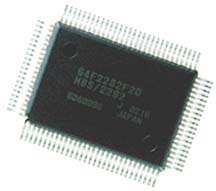| | GLOBAL HOME | UP | | |
|
||
| Hitachi Releases H8S/2282F CAN-Supporting High-Performance 16-Bit Microcomputer Providing Compact Single-Chip Implementation of an Automobile Dashboard System |
| — Motor control timer, LCD controller, and CAN incorporated in a 100-pin package, for smaller, lower-cost systems and short development period — |
|||||||||||||||||||||||||
 “H8S/2282F” CAN-supporting 16-bit microcomputer for automobile dashboard system Tokyo, October 7, 2002— Hitachi, Ltd. (TSE: 6501) today announced the H8S/2282F 16-bit single-chip microcomputer with on-chip flash memory, incorporating a meter gauge drive stepping motor control timer, LCD*1 controller for liquid crystal display, and in-vehicle network standard CAN*2 interface in a compact, low-pin-count package, for automobile dashboard (meter panel) system and vehicle body control applications. Sample shipments will begin on October 21, 2002 in Japan, and volume production in January 2003 in Japan. To handle low-end dashboard systems, the H8S/2282F offers high performance of 20 MHz, plus various on-chip functions required for system implementation, all in a compact 100-pin package. The wide 0.65 mm pin pitch allows installation on a low-cost single-sided printed circuit board, for smaller, lower-cost systems. A CAN bus wake-up function and 32 kHz subclock divider are also provided, enabling systems to be made smaller and development period to be shortened. A mask ROM version has also been developed, and is scheduled for volume production starting in March 2003 in Japan. Recently, the market trend of vehicle systems and FA and similar industrial systems have seen an increasing shift in communication systems from conventional serial communication to high-speed, high-reliability CAN bus communication. The standard automobile dashboard system display comprises four gauges, including speedometer and tachometer, and a need has arisen for a high-performance single-chip microcomputer capable of controlling these gauges in real time. To meet these needs, Hitachi has to date released a lineup of 12 products in the 144-pin H8S/2646 Series and 128-pin H8S/2636 Series of microcomputers with an on-chip CAN interface for dashboard system applications, targeting middle- to high-end systems. However, low-end systems are characterized by space limitations imposed by their installation position, and there is strong demand for a reduction in system size and cost through the use of single-chip implementation. Further demands include the ability to wake-up by the CAN bus operation when the system is in a power-down mode, and a frequency division function for obtaining 32 kHz from the main clock. To meet these market needs for low-end systems, Hitachi has now developed the H8S/2282F 16-bit single-chip microcomputer with on-chip flash memory, offering single-chip system implementation that includes a stepping motor control timer, LCD controller, and built-in CAN interface, all in a compact, low-pin-count 100-pin package. The H8S/2282F employs a 0.35-µm process, and incorporates an H8S/2000 CPU core in Hitachi top-end H8S series 16-bit microcomputer, achieving a minimum instruction execution time of 50 ns (at a 20 MHz operating frequency). This is an F-ZTATTM*3 product with 128 Kbytes of on-chip flash memory, using a single power supply for data writing and erasing. Major features of the H8S/2282F are as follows. < Features >
Mask ROM versions have also been developed -- the H8S/2282M with 128 Kbytes of on-chip ROM and the H8S/2281M with 64 Kbytes. These models are scheduled for volume production in March, 2003. The existing H8S Series C compiler, assembler, linkage editor, librarian, simulator, debugger, etc., are available as a software development environment. As a hardware development environment, the E6000 realtime emulator is available, and the same emulator unit is used as for the H8S/2646 Series.
< Typical Applications >
|
|||||||||||||||||||||||||
| Information contained in this news release is current as of the date of the press announcement, but may be subject to change without prior notice. |
| WRITTEN BY Corporate Communications Division |